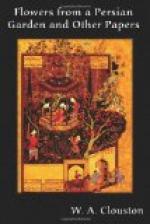The Hebrew commentators are not agreed regarding the cause of Cain’s enmity towards his brother Abel. According to one tradition, Cain and Abel divided the whole world between them, one taking the moveable and the other the immoveable possessions. One day Cain said to his brother: “The earth on which thou standest is mine; therefore betake thyself to the air.” Abel rejoined: “The garment which thou dost wear is mine; therefore take it off.” From this there arose a conflict between them, which resulted in Abel’s death. Rabbi Huna teaches, however, that they contended for a twin sister of Abel; the latter claimed her because she was born along with him, while Cain pleaded his right of primogeniture. After Adam’s first-born had taken his brother’s life, the sheep-dog of Abel faithfully guarded his master’s corpse from the attacks of beasts and birds of prey. Adam and Eve also sat near the body of their pious son, weeping bitterly, and not knowing how to dispose of his lifeless clay. At length a raven, whose mate had lately died, said to itself: “I will go and show to Adam what he must do with his son’s body,” and accordingly scooped a hole in the ground and laid the dead raven therein, and covered it with earth. This having been observed by Adam, he likewise buried the body of Abel. For this service rendered to our great progenitor, we are told, the Deity rewarded the raven, and no one is allowed to injure its young: “they have food in abundance, and their cry for rain is always heard."[62]
[62] The Muhammedan legend informs
us that Cain was
afterwards
slain by the blood-avenging angel. But the
Jewish
traditionists say that God was at length moved by
Cain’s
contrition and placed on his brow a seal, which
indicated
that the fratricide was fully pardoned. Adam
happened
to meet him, and observing the seal on his
forehead,
asked him how he had turned aside the wrath of
God.
He replied: “By confession of my sin and
sincere
repentance.”
On hearing this Adam exclaimed, beating his
breast:
“Woe is me! Is the virtue of repentance
so great
and
I knew it not?”
The Planting of the Vine.
When Noah planted the vine, say the Rabbis, Satan slew a sheep, a lion, an ape, and a sow, and buried the carcases under it; and hence the four stages from sobriety to absolute drunkenness: Before a man begins to drink, he is meek and innocent as a lamb, and as a sheep in the hand of the shearer is dumb; when he has drank enough, he is fearless as a lion, and says there is no one like him in the world; in the next stage, he is like an ape, and dances, jests, and talks nonsense, knowing not what he is doing and saying; when thoroughly drunken, he wallows in the mire like a sow.[63] To this legend Chaucer evidently alludes in the Prologue to the Maniciple’s Tale:
I trow that ye have dronken wine of
ape,
And that is when men plaien at a strawe.




